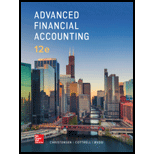
Concept explainers
Consolidated earnings per share:is calculated in the same way as earnings per share is calculated in a single corporation. Consolidated earnings per share is based on the income attributed to the controlling interest and available to parent’s common stock. Basic consolidated EPS is calculated by deducting income to the non-controlling interest and any preferred dividends requirement of the parent company from consolidated net income. The resulting amount is then divided by the weighted-average number of the parent’s common shares outstanding during the period. In computation of EPS, the parent’s percentage of ownership changes frequently when subsidiary convertible bonds and
how rights, warrants and options of subsidiary companies are treated in consolidated EPS.
Want to see the full answer?
Check out a sample textbook solution
Chapter 10 Solutions
EBK ADVANCED FINANCIAL ACCOUNTING
- You are posting questions and giving unhelpful i am also positing you can give my answer i will not give unhelpful but If you unhelpful my answer then I will unhelpful your answer. Also you know unhelpful will remove after coureshero review. So coperate.arrow_forwardPlease provide the answer to this general accounting question using the right approach.arrow_forwardI need answer ✅arrow_forward
 Cornerstones of Financial AccountingAccountingISBN:9781337690881Author:Jay Rich, Jeff JonesPublisher:Cengage Learning
Cornerstones of Financial AccountingAccountingISBN:9781337690881Author:Jay Rich, Jeff JonesPublisher:Cengage Learning Intermediate Accounting: Reporting And AnalysisAccountingISBN:9781337788281Author:James M. Wahlen, Jefferson P. Jones, Donald PagachPublisher:Cengage Learning
Intermediate Accounting: Reporting And AnalysisAccountingISBN:9781337788281Author:James M. Wahlen, Jefferson P. Jones, Donald PagachPublisher:Cengage Learning EBK CONTEMPORARY FINANCIAL MANAGEMENTFinanceISBN:9781337514835Author:MOYERPublisher:CENGAGE LEARNING - CONSIGNMENT
EBK CONTEMPORARY FINANCIAL MANAGEMENTFinanceISBN:9781337514835Author:MOYERPublisher:CENGAGE LEARNING - CONSIGNMENT Auditing: A Risk Based-Approach to Conducting a Q...AccountingISBN:9781305080577Author:Karla M Johnstone, Audrey A. Gramling, Larry E. RittenbergPublisher:South-Western College Pub
Auditing: A Risk Based-Approach to Conducting a Q...AccountingISBN:9781305080577Author:Karla M Johnstone, Audrey A. Gramling, Larry E. RittenbergPublisher:South-Western College Pub Auditing: A Risk Based-Approach (MindTap Course L...AccountingISBN:9781337619455Author:Karla M Johnstone, Audrey A. Gramling, Larry E. RittenbergPublisher:Cengage Learning
Auditing: A Risk Based-Approach (MindTap Course L...AccountingISBN:9781337619455Author:Karla M Johnstone, Audrey A. Gramling, Larry E. RittenbergPublisher:Cengage Learning





